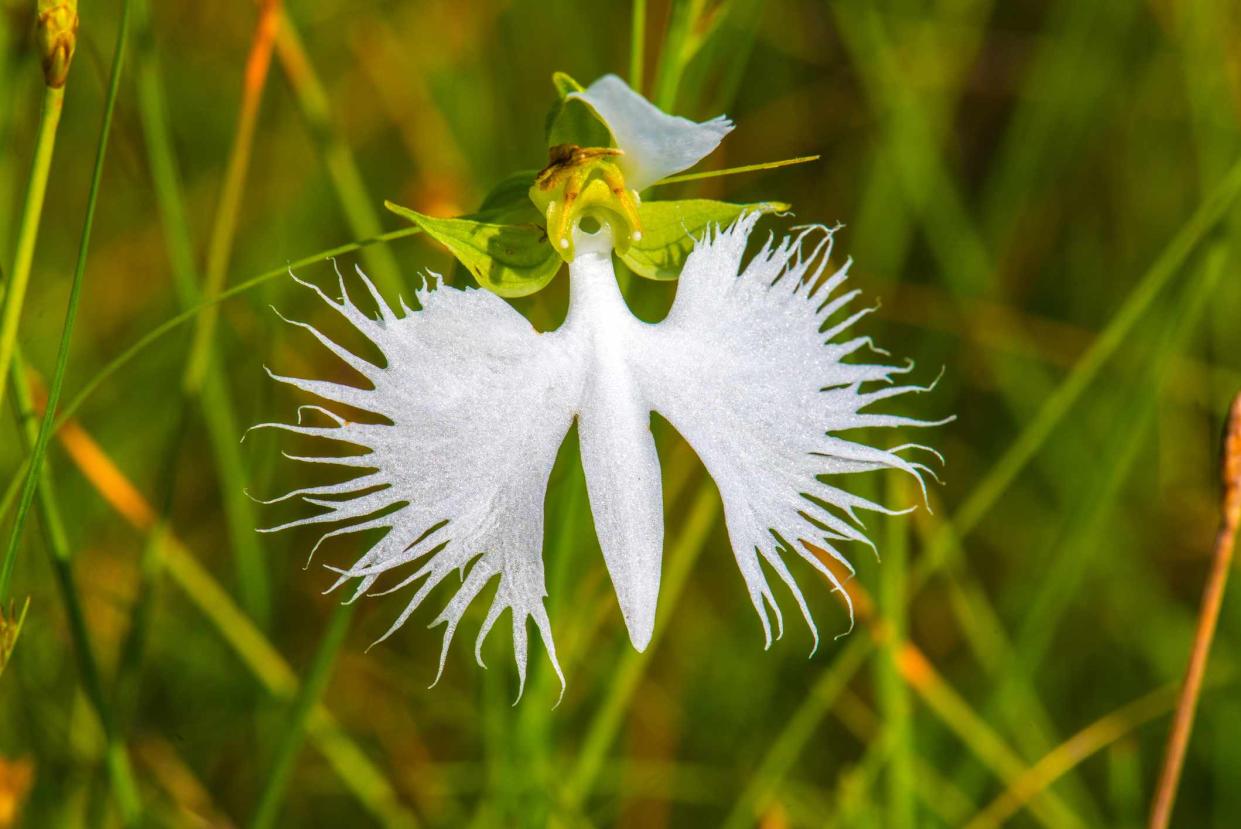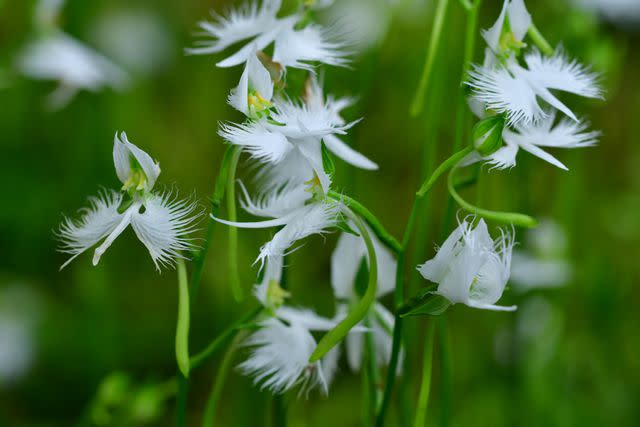How to Grow and Care for White Egret Orchid

LITTLE DINOSAUR / Getty Images
The white egret orchid is named for its uncanny resemblance to a white egret (also known as a Great White Heron) when its wings spread in flight. Native to Japan, Korea, Russia and China, this orchid is known as a terrestrial orchid because it grows in soil as opposed to being found in tree canopies. It likes damp, boggy sites, such as grassy wetlands and steepage slopes (i.e., wetland areas found on the sides of hills). It grows from a small tuber and spreads via tiny offset bulbs.
The white egret orchid is highly sought after for its small but floriferous green and white blooms, with up to eight flowers per stalk.
Common Name | White egret orchid, fringed orchid, crane orchid |
Botanical Name | Habenaria radiata |
Family | Orchidaceae |
Plant Type | Perennial |
Mature Size | 12-18 in. tall |
Sun Exposure | Full sun to part shade |
Soil Type | Sandy, moist, wetlands |
Soil pH | Acidic to neutral |
Bloom Time | Late summer |
Flower Color | White |
Growing Zones | 6-10 (USDA) |
Native Areas | Japan, Korea, China, Russia |

magicflute002 / Getty Images
White Egret Orchid Care
Growing the white egret orchid as a home gardener is not difficult, though its moisture requirements are fairly specific.
Plant the bulbs in growing medium created specifically for orchids; ordinary potting soil may cause fungus to develop.
Keep soil consistently moist during the growing season, then allow to dry out in a cool spot during winter dormancy.
Fertilize lightly with diluted all-purpose plant food (10 to 20% of usual dose) once or twice at the start of the flowering season.
If growing indoors, locate near a window that can be opened to give the plant fresh air.
Remove spent blooms to keep plant looking neat.
The white egret orchid is endangered in the wild due to over-gathering and destruction of its habitat, so it's important to source this plant in a way that does not contribute further to its decline.
Light
Your white egret orchid is adaptable to a range of light conditions, and will perform well in full sun to partial shade. Dappled sunlight or bright morning sunlight are both suitable, though it can also handle plenty of afternoon sunlight and enjoys hot weather in summer.
Soil
A sandy, slightly acidic, well-drained soil is best for the white egret orchid. The standard potting mix designed to be used with orchids is also suitable. Perlite mixed with sand and peat can form a good mixture for growing this orchid. A light layer of dried sphagnum moss on top keeps the soil surface healthy.
Water
During the growing season, keep the soil lightly but consistently moist. If growing in a container, remember the soil will dry out a bit faster. Placing a container with drainage holes in a saucer with pebbles will help the plant absorb water at a uniform rate.
It's important to use water that is free from chlorine, as chlorine can damage this delicate plant. Set chlorinated water for 48 hours to allow the chlorine to dissipate.
Temperature and Humidity
Though some guides say this plant is cold-hardy to Zone 5, to be on the safe side it should be grown within Zones 6 through 10. Once the weather gets hot, be sure the soil remains moist, which may require increasing the amount of water, or using a mister to spray the top layer of soil during the day.
This orchid likes a humid environment, apart from its dormant season (winter), but it also enjoys plenty of fresh air.
Fertilizer
Fertilize your white egret orchid very lightly when blooms begin to appear in spring. A basic all-purpose liquid plant food is recommended, at a diluted strength of 10 to 20% of the recommended amount. Dilute the plant food with water before watering as usual. You can also use organic fertilizers such as fish emulsion or seaweed extracts, but dilute them before use.
Pruning White Egret Orchid
The best time to remove dead growth from an orchid is when the plant begins to go dormant, usually in October. Use a small pair of plant shears and be gentle, as the stems can be easily damaged.
Propagating White Egret Orchid
This plant grows from a tuber that looks like a small bulb brown that is sometimes fuzzy. It should be planted about a half inch deep with the pointed part of the bulb facing up. This plant may seem to grow slowly at first, but once it reaches the flowering season in July it will put on quite a show. Be attentive to the plant's moisture levels and make sure the soil stays moist during the warmest part of the growing season.
Overwintering White Egret Orchid
White egret orchids grown indoors and/or outdoors both need to be overwintered.
Allow the soil to dry out gradually over a couple of weeks. Do this by cutting back on watering, as opposed to moving it to a heated or sunnier area. Then place the container in a cool, dry place until early spring.
Check in on the plant in mid-winter, and if the soil seems extremely dry; you can mist the surface with some water. Inspect for fungus, and remove any affected bulbs so the fungus doesn't spread.
In March or April, gently pull the plants from their containers to separate the fresh new bulbs from the old plant material. Replace the potting medium in the container with a fresh mix before planting the young bulbs. Water lightly but consistently as the plants begin to wake up to their spring growth cycle, then increase water in summer for consistent moisture.
Common Pests and Plant Diseases
This orchid is not bothered by many pests or diseases. However, there is one disease to watch out for: Habaneria mosaic potyvirus (leaf chlorosis), which causes yellowing of the leaves. This is usually due to an iron or magnesium deficiency in the soil or the soil being too alkaline.
Aphids may also be a minor problem, but can be treated with neem oil or insecticidal soap. You may notice mold or mildew on the soil surface if there is too much moisture. Remove any discolored soil and replace with fresh potting mix, and be careful not to overwater.

